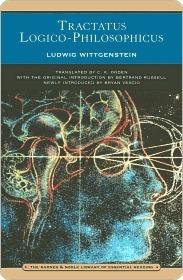More on this book
Community
Kindle Notes & Highlights
In logic nothing is accidental: if a thing can occur in a state of affairs, the possibility of the state of affairs must be written into the thing itself.
If things can occur in states of affairs, this possibility must be in them from the beginning. (Nothing in the province of logic can be merely possible. Logic deals with every possibility and all possibilities are its facts.) Just as we are quite unable to imagine spatial objects outside space or temporal objects outside time, so too there is no object that we can imagine excluded from the possibility of combining with others. If I can imagine objects combined in states of affairs, I cannot imagine them excluded from the possibility of such combinations.
If I know an object I also know all its possible occurrences in states of affairs. (Every one of these possibilities must be part of the nature of the object.) A new possibility cannot be discovered later.
Objects contain the possibility of all situations.
The possibility of its occurring in states of affairs is the form of an object.
Objects are what is unalterable and subsistent; their configuration is what is changing and unstable.
Form is the possibility of structure.
The totality of existing states of affairs is the world.
The existence and non-existence of states of affairs is reality. (We call the existence of states of affairs a positive fact, and their non-existence a negative fact.)
A picture is a model of reality.
In a picture the elements of the picture are the representatives of objects.
The fact that the elements of a picture are related to one another in a determinate way represents that things are related to one another in the same way. Let us call this connexion of its elements the structure of the picture, and let us call the possibility of this structure the pictorial form of the picture.
Pictorial form is the possibility that things are related to one another in the same way as the elements of the picture.
What any picture, of whatever form, must have in common with reality, in order to be able to depict it—correctly or incorrectly—in any way at all, is logical form, i.e. the form of reality.
2.223 In order to tell whether a picture is true or false we must compare it with reality. 2.224 It is impossible to tell from the picture alone whether it is true or false. 2.225 There are no pictures that are true a priori.
Objects can only be named. Signs are their representatives. I can only speak about them: I cannot put them into words. Propositions can only say how things are, not what they are.
The totality of propositions is language.
Man possesses the ability to construct languages capable of expressing every sense, without having any idea how each word has meaning or what its meaning is—just as people speak without knowing how the individual sounds are produced. Everyday language is a part of the human organism and is no less complicated than it. It is not humanly possible to gather immediately from it what the logic of language is. Language disguises thought. So much so, that from the outward form of the clothing it is impossible to infer the form of the thought beneath it, because the outward form of the clothing is not
...more
Philosophy aims at the logical clarification of thoughts. Philosophy is not a body of doctrine but an activity. A philosophical work consists essentially of elucidations. Philosophy does not result in 'philosophical propositions', but rather in the clarification of propositions. Without philosophy thoughts are, as it were, cloudy and indistinct: its task is to make them clear and to give them sharp boundaries.


